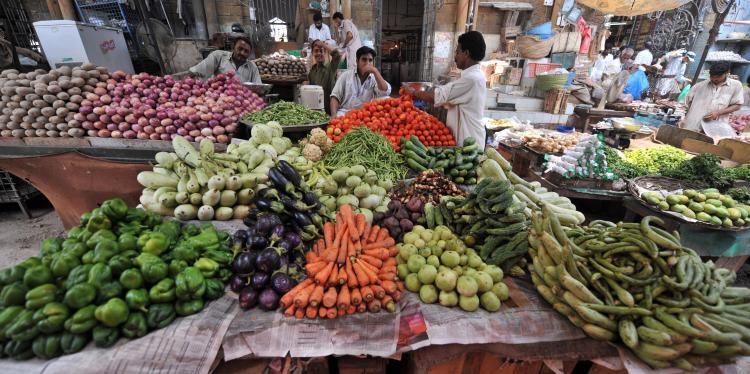A myriad of exotic smells will overwhelm you on your first visit to a Pakistani restaurant. And then there are the flavors! Varied, and easy to digest, if the European stomach does not consider it too spicy. But those who do their own cooking can regulate the degree of spiciness.
Pakistani cuisine is similar to Northern Indian cuisine, but is more heavily influenced by that of Central Asia. Pakistanis eat more meat than their Indian neighbors. This might be due to religious reasons, since Islam does not have a vegetarian diet tradition as it exists in Hinduism, Buddhism, Jainism and Sikkhism.
Basic foods are primarily wheat-based, such as the yeasted Naan bread, and the unleavened roti varieties, particularly chapatti, that are eaten at every meal. Parathi is bread from the Punjab region, enriched with clarified butter. Rice is equally as beloved as bread. It is served simply as a side dish or as a well-seasoned pan-cooked dish, augmented with meat and vegetables. Examples of these seasoned rice mixtures are the much-beloved Biryani (seasoned rice with vegetables), meat curry, and the mild Pulao.
Main meals are augmented by servings of vegetables and meats in spicy sauces. Side dishes are frequently cooked legumes, such as lentils and peas and fruit, pickled vegetables and dairy products, like yogurt and ghee. The use of spices and herbs is particularly notable in the Punjab area—chili, cumin, turmeric, cardamom Indian bay leaves, cloves, ginger, cinnamon, saffron, and several others.
Most favored meats are lamb/mutton, chicken and beef. Religious beliefs forbid the consumption of pork. The traditionally Indian grilled kebabs—marinated meats for grilling—in many variations, from Sindh and Punjab, now belong to Pakistani cuisine and are frequently served with Indian sauce-and-spice combinations.
Shami kebab is a mixture of ground meats and garbanzo beans. Many of the poultry dishes originated in India. The best known is probably the Tandoori chicken [the tandor is a special oven; translator] that has been marinated in plain yogurt.
Sweets are highly prized—halvah being the most commonly available. It is prepared from cream of wheat, sugar, honey and butter or vegetable oil, to which have been added dried fruit, raisins, almonds or even carrots or legumes, which all has been mixed and blended into a sweet dough. Ingredients and flavoring vary widely. Also beloved are milk-based sweets, such as Gulab Jamun.
Most of Pakistan’s commonly consumed beverages are non-alcoholic, since Islam forbids the consumption of alcohol. The national beverage is tea, often served with milk and spices.
Following are two dessert recipes.
Carrot Halvah
Ingredients:
[Note: Number of servings varies according to the persons’ appetite]
1 lb. carrots, washed, peeled and finely grated
3 Tbsp. clarified butter (ghee)
3 Tbsp. finely slivered almonds
2 Tbsp. cream of wheat
2 tbsp. raisins, chopped
1 pint milk
3 tbsp. sugar
1 Tbsp. ground cardamom
Method:
Heat 2 Tbsp. of the clarified butter in a heavy pot and sauté the carrots in it for 20 minutes, stirring often to prevent scorching.
In another pot heat the 1 Tbsp. ghee and roast the cream of wheat and raisins in it.
In a third heavy pot bring the milk to a boil and add the cream of wheat, stirring constantly, to prevent lumping. Add the carrots and almonds and cook the whole mixture for 15 minutes, stirring constantly, until the halvah thickens. Finally add the cardamom.
Fill the mixture into dessert dishes and chill. Decorate the dishes with edible flowers.
Almond-Rice Dessert Serves 6
Ingredients:
1/2 cup water
3 Tbsp. peeled almonds
1 cup whipping cream
1/3 cup sugar
2 heaving Tablespoons rice flour [Mochiko brand is readily available in the USA; translator]
1 pint cold milk
2 Tbsp. rose water
1 Tbsp. each chopped almonds and pistachios
Method:
Boil together the almonds and water, remove from heat, cover and let sit at least 15 minutes.
Slowly bring the sugar and whipping cream to a boil, cooking until the sugar is dissolved, stirring the whole time.
Puree the almonds in the water until a thick liquid is produced. Mix the rice flour into the almond cream. Stir in the cold milk and blend into the whipping cream/sugar mixture.
Stirring constantly, bring all to a boil and boil for 1 minute; then reduce heat and cook slowly until the mixture has thickened somewhat. Add the rose water. Cool.
Fill into dessert dishes and chill. Decorate with chopped almonds and pistachios.






Friends Read Free